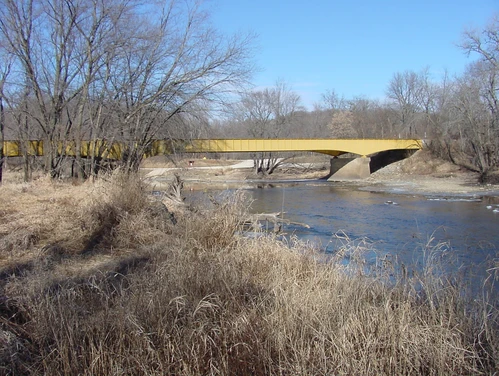- Year constructed: 1938-1939
- Alternate name: Wapsipinicon River Bridge
- Bridge type: Steel Plate Through Girder
- National Register of Historic Places status: Listed
- Length: 303 feet
- Width: 20 feet
- Spans: 3
- FHWA: 222050
- Jurisdiction: Linn county
- Location: Matsell Park Road over the Wapsipinicon River, 5.8 miles northeast of Springville, Section 36, T85N-R5W (Buffalo Township)
Details
Matsell Bridge is a steel plate girder crossing the Wapsipinicon River some six miles northeast of Springville in eastern Linn County. This structure replaced a substantial earlier bridge consisting of a 100-foot through truss, a 140-foot bowstring truss, a 50-foot pony truss, and a 12-foot approach span. This assemblage was erected by the county between 1870 and 1906. When a replacement structure was being considered in July 1938, two possibilities were evaluated. One called for two through trusses with a 50-foot stringer approach span, at a cost of about $23,800. The other option was a through plate girder, estimated at $22,290. E.W. Blumenschein sent plans to Behrens in mid-September, which Behrens, in turn, submitted to Clifford Shoemaker, District Engineer of the Federal Bureau of Public Roads in Omaha, Nebraska. Shoemaker approved the plan for "Iowa PWA Docket 1229-F." In February 1939, Blumenschein reviewed the bridge's steel fabrication at the Illinois Steel Bridge Company's plant in Jacksonville, Illinois: "The two girders were completely assembled for their entire length with floor beams in position and sufficient laterals to insure all main parts in correct position." He concluded that the material and workmanship was "very satisfactory." After his inspection, the members were disassembled and shipped to Linn County for erection. Since its construction, the Matsell Bridge, or Wapsie Bridge as it is locally known, continues to serve local residents while maintaining excellent structural integrity.
In the 1930s the state highway commission began using variable depth plate girders for its long-span beam bridges. These typically employed straight girders with arched or curved haunches at the abutments and piers to help withstand the increased sheer forces at the bearing points. The girders were rigidly joined to form a continuous-span structure. ISHC built several such beam bridges with spans in excess of 100 feet in the 1930s and 1940s. With a span length of 140 feet, the Matsell Bridge in Linn County represents the longest example of steel beam bridge design identified by the historic bridge inventory. It is thus distinguished as the ultimate extension of this relatively common structural type.
Adapted from Roise, Hess, and Crow-Dolby 1992
Areas Served
- Linn
